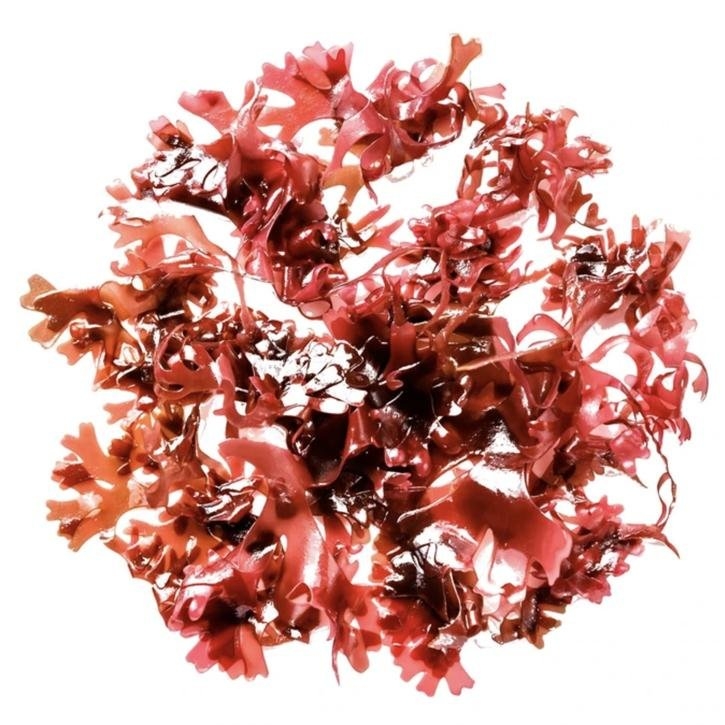It is a freshwater green alga belonging to the family of hematococaceae. It is distributed worldwide, except in Antarctica, and is found in a wide variety of freshwater habitats. It is a unicellular, biflagellate alga, with its cells encapsulated by an ovoid, ellipsoid or practically spherical wall. Most of the protoplast is internally separated from the cell wall, to which it is connected by thin threads that may be simple or branched, and has two equal, apical flagella that penetrate the cellulose wall. Other structures are cup-shaped or tubular chloroplasts, the nucleus located in the chloroplast and many contractile vacuoles.
H. pluvialis presents a life cycle with different cell forms responding to environmental stimuli: vegetative form (green, with presence of flagella), palmella (green, spherical without flagella) and aplanospore (red, spherical without flagella), being this last form where astaxanthin is produced in response to hostile environmental conditions. The aplanospore then functions as a structure of resistance to adverse environmental conditions (excess salinity, high energy radiation, extreme cold, lack of nutrients, desiccation, toxins, etc.). If the environment ceases to be "hostile" the microalga is able to reverse the process by returning to the vegetative configuration, making these characteristics cyclic.
The chemical composition varies depending on the form in which it is found: green (vegetative) or red (aplanospore), with proteins predominating in the green vegetative form, and lipids and carbohydrates in the red or aplanospore form.
In red algae there is a significant increase in the total content of carotenoids as a response to hostile environmental factors, being characteristic the change that occurs in the profile of these compounds with respect to the green form. In this resistance phase of the algae, secondary carotenoids predominate, mainly astaxanthin, which constitutes 80-99% of them, while in the green algae it is not detected.
H. pluvialis is a natural source of astaxanthin that is currently cultivated to obtain this compound used as a supplement for its health benefits.
The effects of astaxanthin are mainly related to its antioxidant and anti-inflammatory activity.
As an antioxidant, it protects different cellular structures such as membranes, mitochondria, DNA, proteins or carbohydrates, to prevent them from deteriorating or modifying their properties.
Astaxanthin is a powerful neutralizer of singlet oxygen (one of the most dangerous oxygen radicals for cells) as well as other reactive oxygen and nitrogen species. Compared to other antioxidants, astaxanthin has been shown to be more potent than beta-carotene, vitamin C, alpha-tocopherol or lutein, among others.
The increased antioxidant capacity of astaxanthin is due to its peculiar molecular structure that allows it to be placed in a strategic location in the cell membrane, protecting it against oxidative damage both internally and externally and increasing its antioxidant potential due to its interactions with the lipid bilayer of the membrane. Astaxanthin is able to cross the blood-brain and blood-retinal barriers, thus protecting the brain and retina, which are particularly susceptible to oxidative stress.
Pregnancy and lactation.
No special precautions at the recommended doses.
None have been described at recommended doses.
None have been described at recommended doses.
-.Córdoba-Castro, NM., Acero-Reyes, N.L., Duque-Buitrago, L.F., Jiménez-Aguilar, L.J., Serna-Jiménez, J.A. (2015) Obtención y caracterización de astaxantina de la microalga Haematococcus Pluvialis. UGCiencia 21, 73-82.
-.Ming Xian Chang, Fan Xiong. Astaxanthin and its effects in inflammatory responses and inflammation-associated diseases. Recent advances and future directions. Molecules 2020, Nov; 25(22): 5342.
-.P. López Roldán, N. Mach. Efecto del consumo de astaxantina en la salud. Rev Esp Nutr Comunitaria. 2012;18(3):162-175.
-.Ranga Rao Ambati, Phang Siew Moi, Sarada Ravi, Ravidhankar Gokare Aswathanarayana. Astaxanthin: sources, extraction, stability, biological activities and its commercial applications. A review. Mar Drugs 2014 Jan; 12(1): 128–152.
-.Kidd P. Astaxanthin, cell membrane nutrient with diverse clinical benefits and anti-aging potential. Altern. Med. Rev. 2011;16:355–364.
-.Galasso C., Orefice I., Pellone P., Cirino P., et al. On the Neuroprotective Role of Astaxanthin: New Perspectives? Mar. Drugs. 2018;16:247.
-.Davinelli S., Nielsen M.E., Scapagnini G. Astaxanthin in Skin Health, Repair, and Disease: A Comprehensive Review. Nutrients. 2018;10:522.
-.M. R. Shah, Y. Liang, J. Cheng, 2 and M. Daroch. Astaxanthin producing green microalga Haematococcus pluvialis: from single cell to high value commercial products. Frontiers in Plant Science. Apriil 2016, vol 7. Article 531.
